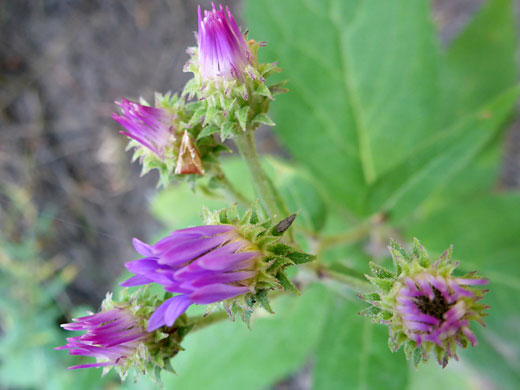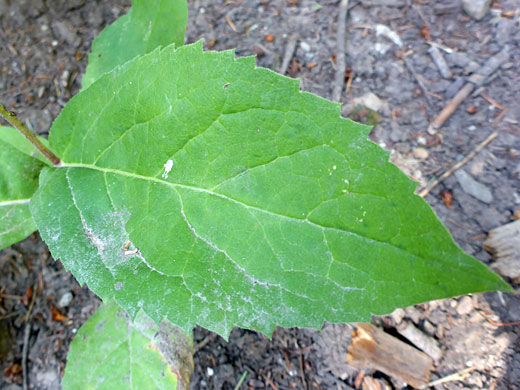
Pink florets and green phyllaries - eurybia conspicua along the Snow Pass Trail, Yellowstone National Park, Wyoming
Common name:
Western showy aster
Family:
Scientific name:
Eurybia conspicua
Main flower color:
Range:
From Oregon and Washington to South Dakota
Height:
Up to 40 inches
Habitat:
Meadows, aspen and coniferous woodland; up to 8,200 feet
Leaves:
Alternate, quite thick, sessile or clasping, toothed, lanceolate to oblanceolate; up to 7 inches long and 3 inches across
Season:
June to September
Flowerheads of eurybia conspicua consist of between 12 and 35 purple or bluish ray florets, about half an inch long, and around 50 yellow disc florets. The bell-shaped involucre is lined by four or five rows of green, differently-sized phyllaries, sometimes purple at the tip. Phyllary margins are ciliate, and the tips bend outwards, by 90 degrees or more. Phyllaries are densely glandular, as are the stems, especially towards the top. The inflorescence is an open cluster of between 50 and 50 heads.
Plants produce one stem, generally unbranched, bearing broad, toothed leaves at alternate intervals. Lower stem leaves are widest towards the tip (oblanceolate), while those higher up are lanceolate, widest towards the base. Leaves have a prominent, light-colored center vein, and branched side veins. Leaf teeth terminate in a tiny spine.
Plants produce one stem, generally unbranched, bearing broad, toothed leaves at alternate intervals. Lower stem leaves are widest towards the tip (oblanceolate), while those higher up are lanceolate, widest towards the base. Leaves have a prominent, light-colored center vein, and branched side veins. Leaf teeth terminate in a tiny spine.
All Contents © Copyright The American Southwest | Comments and Questions | Contribute | Site Map


